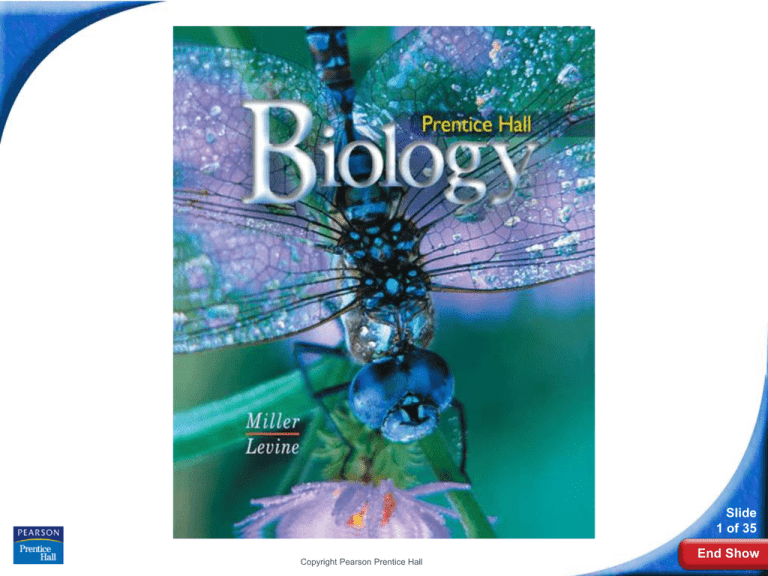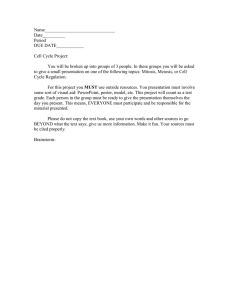
biology
Slide
1 of 35
Copyright Pearson Prentice Hall
End Show
11-4 Meiosis
11-4 Meiosis
Slide
2 of 35
Copyright Pearson Prentice Hall
End Show
11-4 Meiosis
Each organism must inherit a single copy of every
gene from each of its “parents.”
Gametes are formed by a process that separates the
two sets of genes so that each gamete ends up with
just one set.
Slide
3 of 35
Copyright Pearson Prentice Hall
End Show
11-4 Meiosis
Chromosome Number
Chromosome Number
All organisms have
different numbers of
chromosomes.
A body cell in an adult fruit
fly has 8 chromosomes: 4
from the fruit fly's male
parent, and 4 from its
female parent.
Slide
4 of 35
Copyright Pearson Prentice Hall
End Show
11-4 Meiosis
Chromosome Number
These two sets of chromosomes are homologous.
Each of the 4 chromosomes that came from the male
parent has a corresponding chromosome from the
female parent.
Slide
5 of 35
Copyright Pearson Prentice Hall
End Show
11-4 Meiosis
Chromosome Number
A cell that contains both sets of homologous
chromosomes is said to be diploid.
The number of chromosomes in a diploid cell is
sometimes represented by the symbol 2N.
For Drosophila, the diploid number is 8, which can be
written as 2N=8.
Slide
6 of 35
Copyright Pearson Prentice Hall
End Show
11-4 Meiosis
Chromosome Number
The gametes of sexually reproducing organisms
contain only a single set of chromosomes, and
therefore only a single set of genes.
These cells are haploid. Haploid cells are
represented by the symbol N.
For Drosophila, the haploid number is 4, which can
be written as N=4.
Slide
7 of 35
Copyright Pearson Prentice Hall
End Show
11-4 Meiosis
Phases of Meiosis
What happens during the process of
meiosis?
Slide
8 of 35
Copyright Pearson Prentice Hall
End Show
11-4 Meiosis
Phases of Meiosis
Phases of Meiosis
Meiosis is a process of reduction
division in which the number of
chromosomes per cell is cut in half
through the separation of homologous
chromosomes in a diploid cell.
Slide
9 of 35
Copyright Pearson Prentice Hall
End Show
11-4 Meiosis
Phases of Meiosis
Meiosis involves two divisions, meiosis I and
meiosis II.
By the end of meiosis II, the diploid cell that
entered meiosis has become 4 haploid cells.
Slide
10 of 35
Copyright Pearson Prentice Hall
End Show
11-4 Meiosis
Phases of Meiosis
Meiosis I
Interphase I
Meiosis I
Prophase I
Metaphase I
Anaphase I
Telophase I
and
Cytokinesis
Slide
11 of 35
Copyright Pearson Prentice Hall
End Show
11-4 Meiosis
Phases of Meiosis
Cells undergo a round of
DNA replication, forming
duplicate chromosomes.
Interphase I
Slide
12 of 35
Copyright Pearson Prentice Hall
End Show
11-4 Meiosis
Phases of Meiosis
Each chromosome pairs
with its corresponding
homologous
chromosome to form a
tetrad.
MEIOSIS I
Prophase I
There are 4 chromatids in
a tetrad.
Slide
13 of 35
Copyright Pearson Prentice Hall
End Show
11-4 Meiosis
Phases of Meiosis
When homologous chromosomes form tetrads in
meiosis I, they exchange portions of their
chromatids in a process called crossing over.
Crossing-over produces new combinations of
alleles.
Slide
14 of 35
Copyright Pearson Prentice Hall
End Show
11-4 Meiosis
Phases of Meiosis
Spindle fibers attach to
the chromosomes.
MEIOSIS I
Metaphase I
Slide
15 of 35
Copyright Pearson Prentice Hall
End Show
11-4 Meiosis
Phases of Meiosis
The fibers pull the
homologous
chromosomes toward
opposite ends of the
cell.
MEIOSIS I
Anaphase I
Slide
16 of 35
Copyright Pearson Prentice Hall
End Show
11-4 Meiosis
Phases of Meiosis
Nuclear membranes form.
MEIOSIS I
Telophase I and
Cytokinesis
The cell separates into two
cells.
The two cells produced by
meiosis I have
chromosomes and alleles
that are different from each
other and from the diploid
cell that entered meiosis I.
Slide
17 of 35
Copyright Pearson Prentice Hall
End Show
11-4 Meiosis
Phases of Meiosis
Meiosis II
The two cells produced by meiosis I now enter a
second meiotic division.
Unlike meiosis I, neither cell goes through
chromosome replication.
Each of the cell’s chromosomes has 2 chromatids.
Slide
18 of 35
Copyright Pearson Prentice Hall
End Show
11-4 Meiosis
Phases of Meiosis
Meiosis II
Telophase I and
Cytokinesis I
Meiosis II
Prophase II
Metaphase II
Anaphase II Telophase II
and
Cytokinesis
Slide
19 of 35
Copyright Pearson Prentice Hall
End Show
11-4 Meiosis
Phases of Meiosis
Meiosis I results in two
haploid (N) daughter
cells, each with half the
number of chromosomes
as the original cell.
MEIOSIS II
Prophase II
Slide
20 of 35
Copyright Pearson Prentice Hall
End Show
11-4 Meiosis
Phases of Meiosis
The chromosomes line
up in the center of cell.
MEIOSIS II
Metaphase II
Slide
21 of 35
Copyright Pearson Prentice Hall
End Show
11-4 Meiosis
Phases of Meiosis
The sister chromatids
separate and move
toward opposite ends of
the cell.
MEIOSIS II
Anaphase II
Slide
22 of 35
Copyright Pearson Prentice Hall
End Show
11-4 Meiosis
Phases of Meiosis
Meiosis II results in four
haploid (N) daughter cells.
MEIOSIS II
Telophase II and Cytokinesis
Slide
23 of 35
Copyright Pearson Prentice Hall
End Show
11-4 Meiosis
Gamete Formation
Gamete Formation
In male animals, meiosis results in four equal-sized
gametes called sperm.
Slide
24 of 35
Copyright Pearson Prentice Hall
End Show
11-4 Meiosis
Gamete Formation
In many female animals, only one egg results from
meiosis. The other three cells, called polar bodies,
are usually not involved in reproduction.
Slide
25 of 35
Copyright Pearson Prentice Hall
End Show
11-4 Meiosis
Comparing Mitosis and Meiosis
How is meiosis different from mitosis?
Slide
26 of 35
Copyright Pearson Prentice Hall
End Show
11-4 Meiosis
Comparing Mitosis and Meiosis
Comparing Mitosis and Meiosis
Mitosis results in the production of two
genetically identical diploid cells. Meiosis
produces four genetically different
haploid cells.
Slide
27 of 35
Copyright Pearson Prentice Hall
End Show
11-4 Meiosis
Comparing Mitosis and Meiosis
Mitosis
• Cells produced by mitosis have the same number
of chromosomes and alleles as the original cell.
• Mitosis allows an organism to grow and replace
cells.
• Some organisms reproduce asexually by mitosis.
Slide
28 of 35
Copyright Pearson Prentice Hall
End Show
11-4 Meiosis
Comparing Mitosis and Meiosis
Meiosis
• Cells produced by meiosis have half the number
of chromosomes as the parent cell.
• These cells are genetically different from the
diploid cell and from each other.
• Meiosis is how sexually-reproducing organisms
produce gametes.
Slide
29 of 35
Copyright Pearson Prentice Hall
End Show
11-4
Click to Launch:
Continue to:
- or -
Slide
30 of 35
End Show
Copyright Pearson Prentice Hall
11-4
If the body cells of humans contain 46
chromosomes, a single sperm cell should have
a. 46 chromosomes.
b. 23 chromosomes.
c. 92 chromosomes.
d. between 23 and 46 chromosomes.
Slide
31 of 35
End Show
Copyright Pearson Prentice Hall
11-4
During meiosis, the number of chromosomes
per cell is cut in half through the separation of
a. daughter cells.
b. homologous chromosomes.
c. gametes.
d. chromatids.
Slide
32 of 35
End Show
Copyright Pearson Prentice Hall
11-4
The formation of a tetrad occurs during
a. anaphase I.
b. metaphase II.
c. prophase I.
d. prophase II.
Slide
33 of 35
End Show
Copyright Pearson Prentice Hall
11-4
In many female animals, meiosis results in the
production of
a. only 1 egg.
b. 1 egg and 3 polar bodies.
c. 4 eggs.
d. 1 egg and 2 polar bodies.
Slide
34 of 35
End Show
Copyright Pearson Prentice Hall
11-4
Compared to egg cells formed during meiosis,
daughter cells formed during mitosis are
a. genetically different, while eggs are
genetically identical.
b. genetically different, just as egg cells are.
c. genetically identical, just as egg cells are.
d. genetically identical, while egg cells are
genetically different.
Slide
35 of 35
End Show
Copyright Pearson Prentice Hall
END OF SECTION





